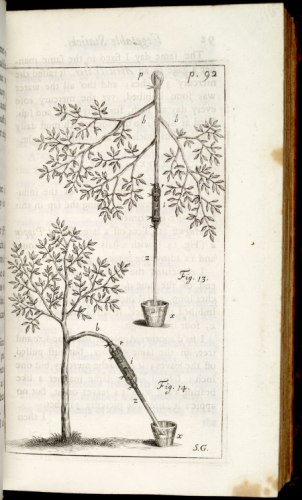April 19

Illustration from Stephen Hales’ Vegetable Statics
- 1793: April 19, 1793 – Showers of hail, sleet. Gleams. Timothy, who has withdrawn himself for several days, appears.
- 1792: April 19, 1792 – Redstart appears. Daffodils are gone: mountain-snow-drops, & hyacinths in bloom; the latter very fine: fritillaries going. Vast flood at Whitney in Oxfordshire, on the Windrush.
- 1791: April 19, 1791 – Mr Chandler & son went away on a visit. Began to use the winter lettuce. Tho’ a swallow or two were seen in the village as long ago as the 7th yet have they absconded for some time past! The house-martin is also withdrawn; no Swift has yet appeared at Selborne; what was seen was at Bentley.
- 1789: April 19, 1789 – The vines of John Stevens, which were trimmed late, not till March, bleed much; & will continue to do so until the leaf is fully expanded. It is remarkable, that tho’ this is the case while the trees are leafless, yet lop them as much as you please when the foliage is out, they will not shed one drop. Dr Hales was not acquainted with this circumstance when he cut-off a large bough of his vine at Teddington late in the spring; & it was lucky for science that he was not. For his sollicitude for his vine, & his various attempts to stop the effusion of the sap, led him step by step to many expedients, which by degrees brought on the abundance of curious experiments, & ended in that learned publication known by the name of Vegetable Statics, a work which has done much honour to the Author, & has been translated into many modern languages.
- 1788: April 19, 1788 – Mended the fences this week all round my outlet. Insects abound; yet no swallows to be seen. The voice of the Cuckoo is heard in the land.
- 1786: April 19, 1786 – Sowed holly-hocks, columbines, & sweet Williams.
- 1784: April 19, 1784 – Timothy the tortoise begins to stir: he heaves-up the mould that lies over his back. Redstart is heard at the verge of the highwood against the common.
- 1783: April 19, 1783 – One house-martin about the stables. Sultry out of the wind. The garden is watered every day.
- 1778: April 19, 1778 – The little laughing yellow wren whistles.
- 1776: April 19, 1776 – Grass-hopper-lark whispers. The bombylius medius is much about in March & the beginning of April, & soon seems to retire. It is a very early insecte. Pulled won the old martins nests against the brew-house & stable: they get foul & full of vermin. These abounded with fleas, & the cases of Hippoboscae hirundinis. Besides while these birds are building they are much more in sight, & very amusing.
- 1774: April 19, 1774 – The titlark begins to sing: a delicate songster!
- 1773: April 19, 1773 – Blackcap sings. The sedge-bird a delicate polyglott.
- 1772: April 19, 1772 – Severe wind. Snow on the ground. Swallows abound.
- 1771: April 19, 1771 – Hay risen to four pounds per ton. High rumbling wind.
- 1769: April 19, 1769 – Regulus on cristatus voce stridula locustae. This is the largest of the three willow wrens: it haunts the tops of tall trees making a shivering noise & shaking its wings. It’s colours are more vivid than those of the other two species.
Notes:
Stephen Hales published Vegetable Statics (click the link for a full scan of this handsome book) in 1727. A very model of the early Enlightenment scientist, he went on to do early experiments in animal circulation; invented several useful farming devices, irrigation systems, and life-saving ventilators for closed environments; and founded The Society for the Encouragement of Arts, Manufactures, and Commerce. Like Gilbert White, he was a country clergyman.
The 1788 entry refers to the Song of Solomon 2.12: “The flowers appear on the earth; the time of the singing of birds is come, and the voice of the turtle is heard in our land” (turtledove, that is).
Hippoboscae hirundinis, or stenepteryx hirunidinis, an unappealing tick-like parasite.
 Theme Ported to
Theme Ported to